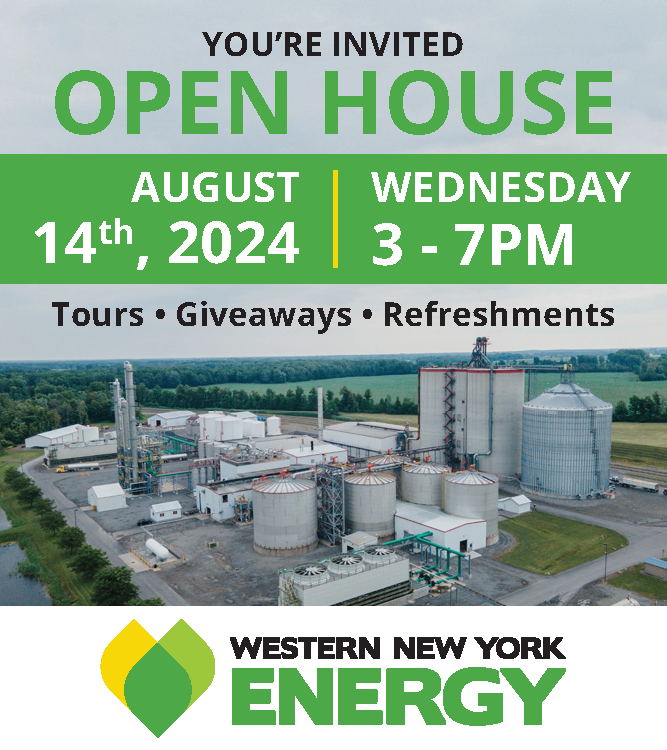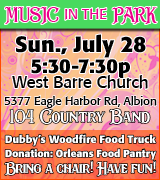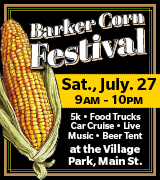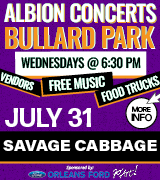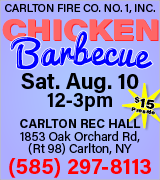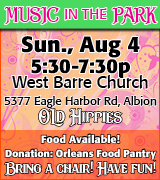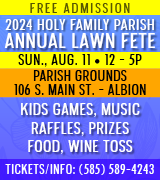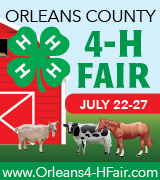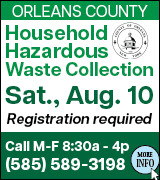Somerset will celebrate 200th anniversary from July 21-23
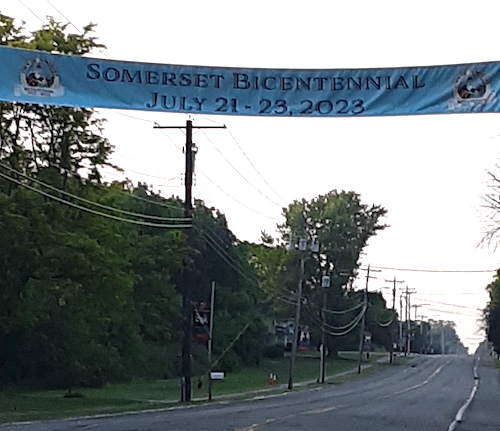
Photo by Ginny Kropf: The banner across Quaker Road in Barker advertises the town of Somerset’s bicentennial celebration July 21, 22 and 23.
BARKER – The town of Somerset is making plans to celebrate a milestone in its history this month.
On July 21, 22 and 23 the town will celebrate its bicentennial.
For months, a committee consisting of Jeff and Amy Dewart, Tracy Carmer, Gail Damon, Fred Leuer, Priscilla Whitford, Grace Bodine, Jim Hoffman, Dave Hotaling, Wayne Rider and Aaron Davis has been planning the three days full of events.
An opening ceremony will take place at 4 p.m. July 21, followed by a cruise-in on Main Street from 4 to 8 p.m.; music in Barker Village Park from 5 to 8 p.m.; vendors in the park from 4 to 8 p.m.; and a corn hole tournament at 5 p.m. at Barker fire hall.
Saturday’s festivities begin at 9 a.m. with a 5K race on Main Street. At 10 a.m., Somerset Youth Baseball/Softball will begin, with All-Star games at Somerset Town Park. A corn hole tournament again takes place at Barker fire hall at 10 a.m. From noon to 6 p.m., vendors will be set up in the Village Park and historical displays will be set up in Barker fire hall.
The bicentennial parade will begin at 2 p.m. on Quaker Road.
The fire hall is also the setting for food trucks from noon to 6 p.m. and for beer and Big Band Night from 7 to 11 p.m. Fireworks cap off the day’s events at 10 p.m. between the school and the fire hall.
On Sunday, events begin with a community church service from 9:30 to 10-:30 a.m. at Faith Community Church, where Barker Lions Club will service a chicken barbecue from 11 a.m. until sold out. There will also be a petting zoo at the church from 11 a.m. to 3 p.m. and the Barker Community Band will play there from 1 to 3 p.m. An ice cream social is also scheduled at the church from 1 to 3 p.m.
A tractor display will be set up from 11 a.m. to 3 p.m. at the Town Highway Department.
A closing ceremony will take place at 3 p.m. at Faith United Methodist Church.
The town of Somerset was established on Feb. 8, 1823 when several citizens met at the home of Silas Mead. Originally part of the Holland Purchase, 23,314 acres fronting on eight miles of Lake Ontario, was separated from the northern section of Hartland on the first Tuesday of April, and the township was born. Historical accounts note that the founding fathers were men of sturdy stock who acquired their small empires for two or three dollars an acre.
Decisions made at this meeting included electing officials, one being James Wisner, supervisor, and raising $150 for roads and bridges.
Two theories have evolved regarding naming of the township. One proposes that the name is of English origin relating to Somersetshire, a maritime county in southwest England. It could also be presumed the name originated with John Adam Pease, who came here in 1817 with his wife Hannah from Somerset County, N.J.
A small village developed around the four corners of Somerset, where the original settlers were Isaac Starbuck, William Harrington, Isaac Haight and David Lockwood.
The town of Somerset covers 23,000 acres of level farm land, adapted to the growing of fruit, vegetable crops and grain.
There were no modern tools in the early days and roads were scraped with a section of a log seven or eight feet long. An old saw blade was inserted in the log a little off center to make it draw at an angle. Sometimes four or six horses were required to draw each scraper. Roads needed attention after every hard rain.
A small group of Presbyterians formed the first church on Jan. 26, 1824.
Most of the land in the town had been purchased by 1835 and population had increased to 1730. There were 12 school districts and a militia of 155 men. By 1850 it boasted three churches, several shops, two stores and a post office. A fine hotel welcomed visitors and the schools were highly praised.
On Jan. 7, 1870, tracks of the Rome, Watertown and Ogdensburg Railroad were laid on land offered by David Barker. Originally, the survey called for the tracks to run through the Sharpsteen property, now owned by Barker Central School, but Barker’s shrewd donation ensured the railroad’s passage through his farm. People of Somerset raised $2,000 for a depot and Somerset Station served the area for several years. When Somerset Village began to decline with interest centered around the depot, the name was changed to Barker.
Settlement grew around the railroad and a school and post office were added in 1878. The center of Barker village was established in 1878 as the corner of Main Street and Quaker Road. William Atwater surveyed the site and marked Main Street with a line from the corner to the east line of David Barker’s property. The village of Barker grew rapidly, with the addition of East Avenue, surveyed in 1881 and bordering the Coleman farm; Church Street, laid out in 1886; and a subdivision along Pallister Avenue by Perry Pallister.
A fire leveled all of Main Street west of the depot in 1895, but business places were soon rebuilt, and Barker was again thriving after the turn of the century.
The village of Barker was incorporated in 1908.
Although most of the residents of the town of Somerset are now employed in the industries of the town and those nearby, Somerset remains a fairly rural community owing to its rich soil conducive to growing fruit.



















